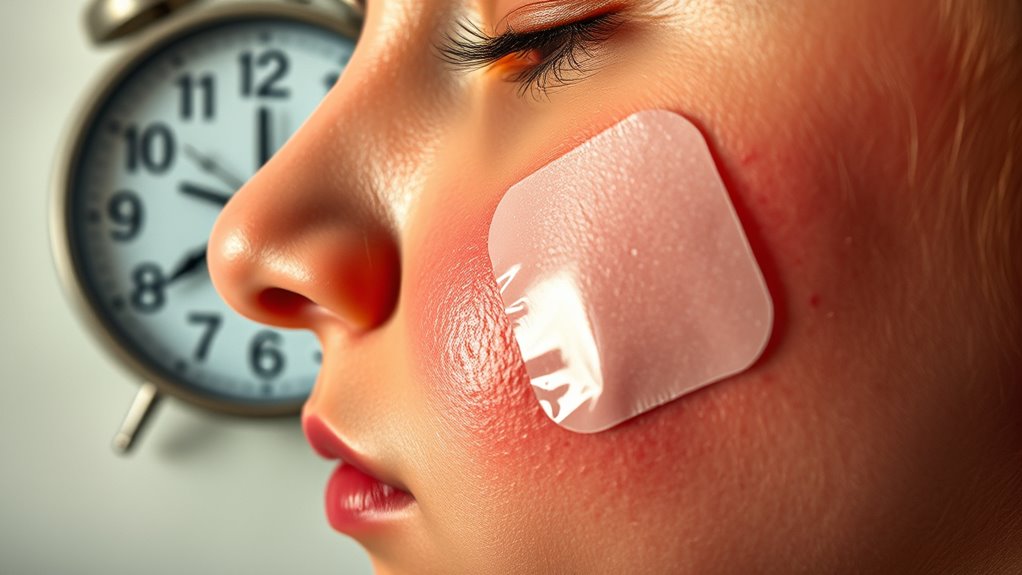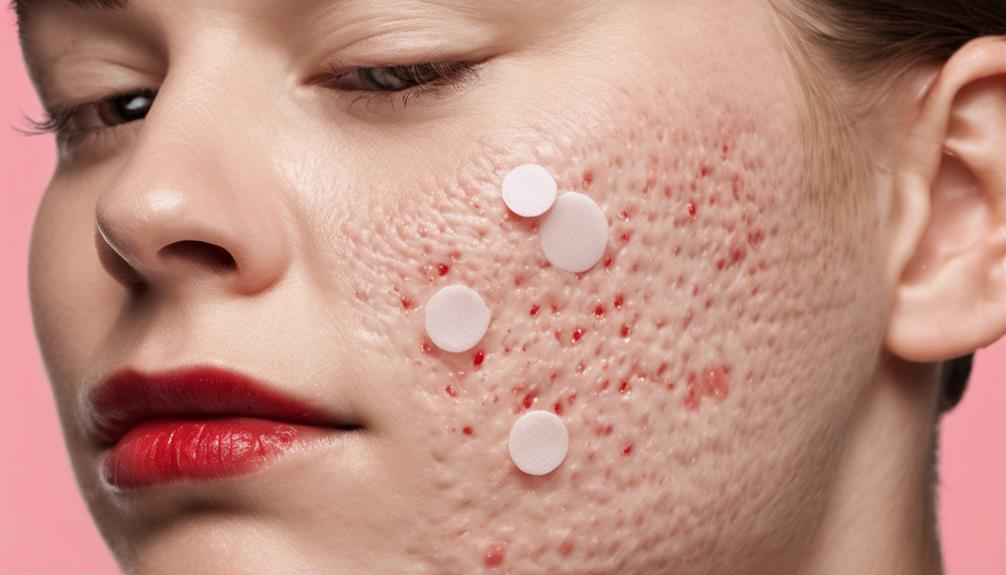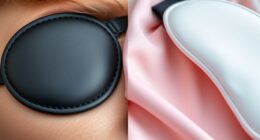Wearing a pimple patch for 12 hours can be brilliant for quick healing. The patch creates a protective barrier that absorbs fluids and promotes recovery. However, if the patch gets saturated or you have sensitive skin, it might lead to irritation. It’s also essential to apply it on clean skin for the best results. Want to know how to maximize the benefits or explore alternatives? There’s plenty more to contemplate!
Key Takeaways
- Wearing a pimple patch for 12 hours can enhance healing by creating a moist environment and absorbing excess fluids from the blemish.
- Pimple patches are best applied overnight, allowing for uninterrupted treatment without the risk of touching or picking at the pimple.
- Leaving the patch on for an extended period can be effective, but ensure the skin is clean and dry before application for optimal adhesion.
- Some patches contain active ingredients, so monitor for irritation; 12 hours might be too long for sensitive skin types.
- If the patch becomes saturated or loses adhesion, replace it promptly to maintain effectiveness and prevent further irritation.
Understanding Pimple Patches

When you’re dealing with a breakout, pimple patches can be a game-changer. Made from materials like hydrocolloid and infused with ingredients such as salicylic acid or tea tree oil, these patches offer targeted treatment. They come in various designs, including transparent options that blend with your skin and even glow-in-the-dark varieties for nighttime use. Each patch is sized to fit individual pimples, making them discreet enough to wear during the day.
Pimple patches provide targeted treatment with ingredients like salicylic acid, helping you tackle breakouts effectively.
The convenience of applying a patch helps prevent picking and shields your skin from irritants. Plus, they create a moist environment that accelerates healing while reducing inflammation, which is especially beneficial due to the protective barrier they provide against bacteria and pollutants. With their rising popularity, pimple patches are quickly becoming a staple in acne care routines.
How Pimple Patches Work
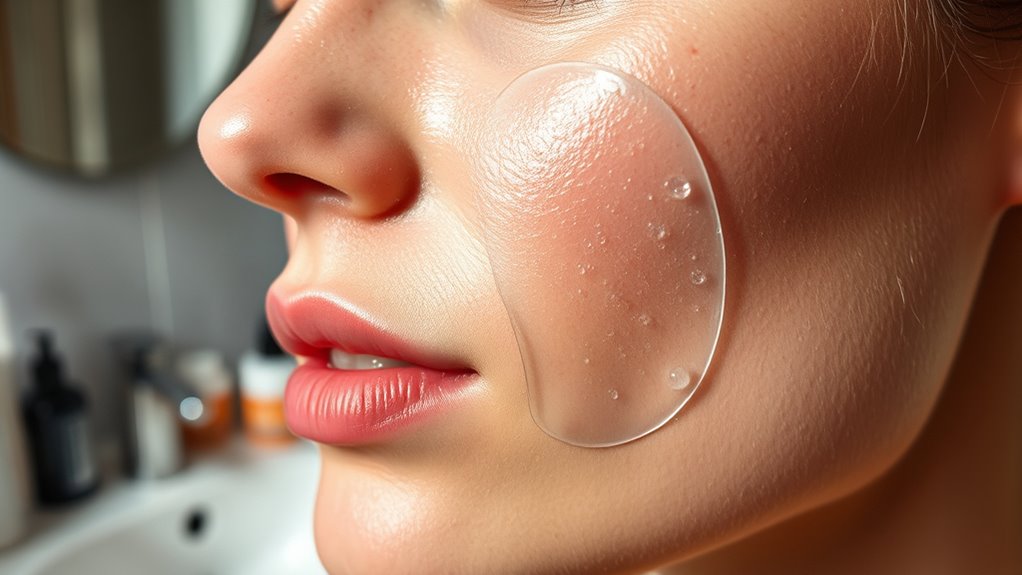
Pimple patches work by creating a protective barrier over your blemish, which helps to speed up the healing process. Made primarily of hydrocolloid, these gel-based patches absorb excess fluids and impurities, keeping the area moist and promoting faster recovery. Additionally, these patches function as a barrier to expedite the healing process of open sores.
When you apply a patch directly to a pimple, it prevents you from touching or picking, reducing the risk of infection and scarring. Regular use can effectively minimize pimple size, inflammation, and redness, particularly for superficial blemishes. While they’re not suited for deep or cystic acne, their gentle nature makes them suitable for various skin types. Plus, you can wear them overnight or during the day, providing discreet treatment for your breakouts.
The Different Types of Pimple Patches
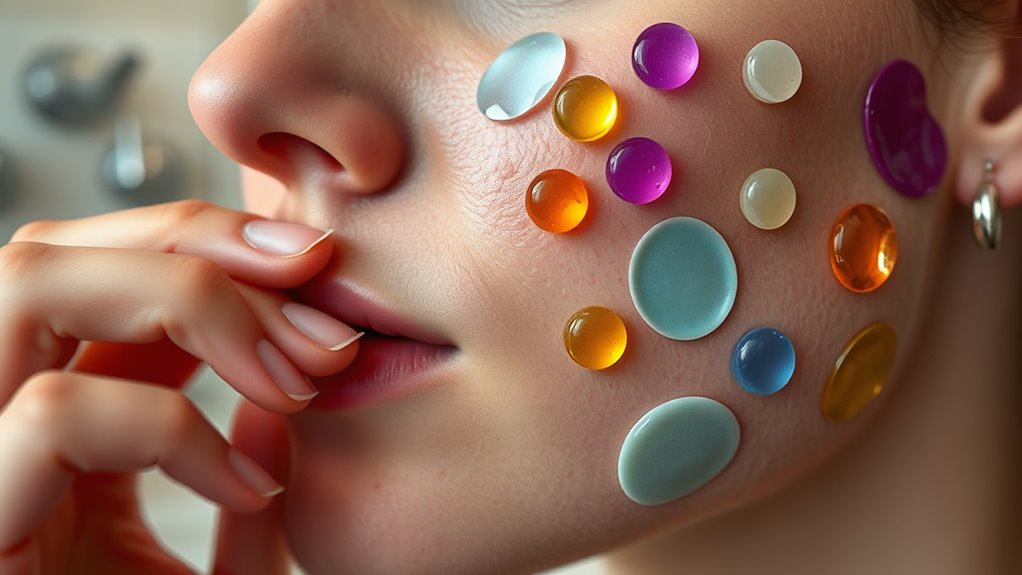
As you explore the world of pimple patches, you’ll find a variety of options tailored to different skin needs and concerns.
Hydrocolloid patches are great for surface-level pimples, absorbing excess fluid and promoting healing. Additionally, these patches are made of hydrocolloid material, which helps to draw out impurities from the pimple.
Medicated patches, containing ingredients like salicylic acid, target bacteria directly and work well for blackheads and whiteheads.
If you’re dealing with deep cystic pimples, microneedling patches use tiny needles to deliver active ingredients deeper into the skin.
You’ll also encounter specialized patches infused with tea tree oil for antibacterial benefits or aloe vera for soothing hydration.
Each type offers unique advantages, catering to your specific skin challenges, so you can choose what’s best for your needs.
Benefits of Using a Pimple Patch
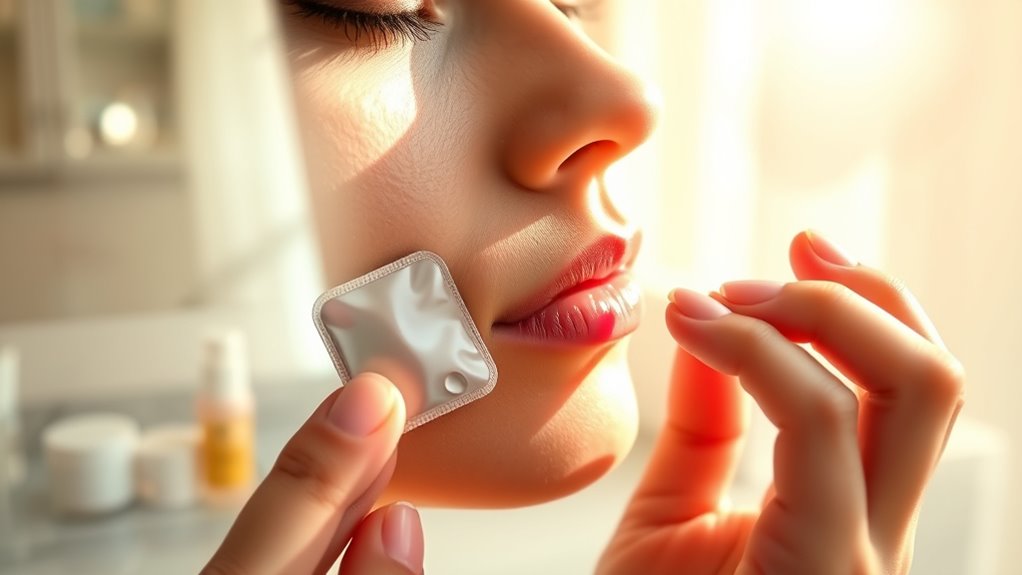
Using pimple patches can greatly enhance your skincare routine by addressing multiple concerns at once. They reduce inflammation by absorbing pus and fluids, which minimizes redness and swelling. Some patches contain antibacterial ingredients to fight infection and further decrease inflammation. Additionally, many patches are designed specifically for cystic acne to provide targeted treatment for deeper blemishes. The best patches often utilize hydrocolloid technology for optimal results.
By creating a moist environment, hydrocolloid patches accelerate healing and help prevent scarring.
Pimple patches also act as a barrier against dirt, bacteria, and environmental pollutants, reducing irritation and contamination. Their discreet design allows you to wear them under makeup, boosting your confidence in social situations. Furthermore, using patches with fun designs can make the treatment process feel more enjoyable and less daunting.
Ultimately, they offer a quick solution for covering up pimples during special occasions, making you feel more at ease.
Application Tips for Maximum Effectiveness
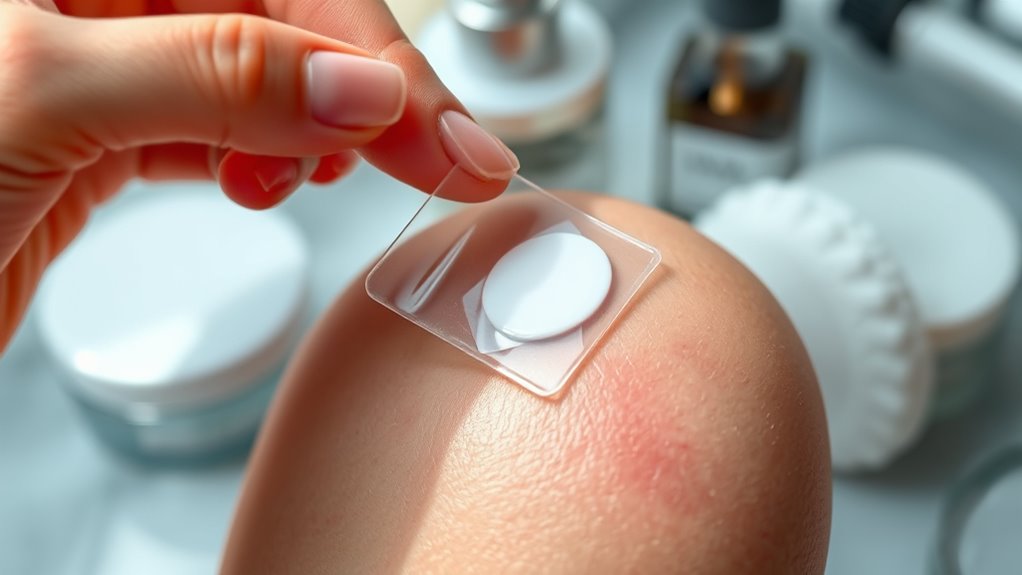
To achieve the best results with pimple patches, start by selecting the right type for your skin’s needs. Hydrocolloid patches work wonders for absorbing impurities in whiteheads, while medicated patches with salicylic acid or benzoyl peroxide target inflammation. It is also important to consider patch size and shape as they can impact adhesion and coverage.
Before applying, cleanse your face thoroughly and pat it dry to guarantee proper adhesion. Avoid heavy moisturizers, as they can interfere with the patch’s effectiveness.
When applying, carefully remove the patch from its packaging, center it over the blemish, and press down gently. For best results, leave the patch on for six to eight hours, preferably overnight.
Finally, resist the urge to touch or fidget with the patch, and give your skin breaks between applications for the best outcomes.
My Experience: Applying the Patch
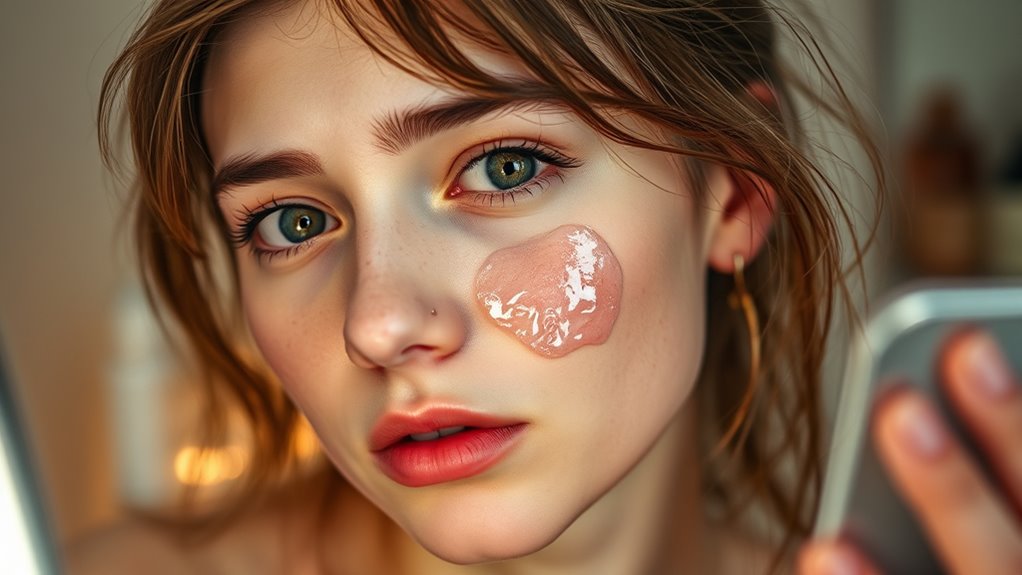
After preparing your skin and selecting the right patch, the actual application is straightforward yet important for effectiveness.
Start by using a gentle cleanser to guarantee your pimple is clean and dry. Pat the area dry with a towel to remove any moisture, as this enhances the patch’s adhesion.
Begin with a gentle cleanser to ensure your pimple is clean and dry, then pat the area to boost patch adhesion.
Depending on your acne’s needs, you might choose a hydrocolloid, medicated, or microneedling patch. Once you’ve placed the patch, apply light pressure with your finger for 20 to 30 seconds to activate the adhesive. This snug fit helps create a tight seal, protecting the pimple from irritants. Pimple patches are available in various sizes to cover or hide acne, allowing for targeted treatment.
Finally, consider wearing the patch overnight for best results, but be mindful not to exceed 24 hours to avoid irritation.
Observing Changes After 12 Hours
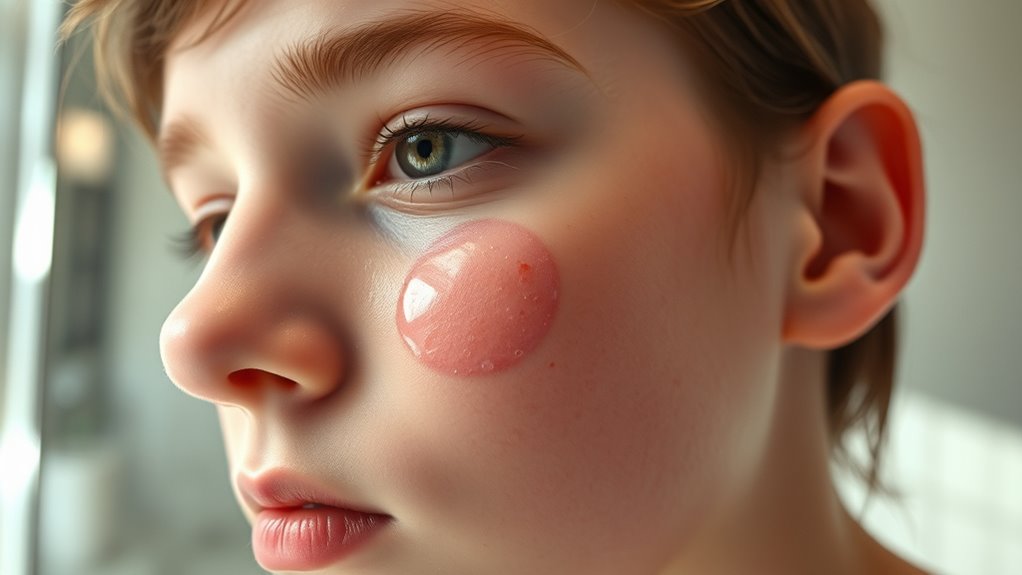
Once you’ve worn a pimple patch for 12 hours, you’ll likely start noticing some positive changes. The patch effectively draws out impurities, greatly reducing the size of the pimple. You’ll appreciate how it minimizes redness and inflammation, making the blemish less noticeable. The moist environment under the patch promotes healing, which is why many users see improvements within just a few hours. If the pimple’s stubborn, leaving the patch on longer can enhance these benefits. Just remember, pimple patches work best on hydrocolloid pus-filled pimples and red spots, so don’t expect miracles with deep cysts.
Comparing Results: Pimple Patch vs. No Patch

While some people may rely on traditional treatments for acne, using pimple patches can greatly enhance your skincare routine.
Pimple patches effectively reduce the size and severity of surface-level pimples over time, often outperforming no patch treatments. They create a moist environment that absorbs pus and fluid, promoting healing while preventing further irritation from dirt and bacteria. Pimple patches are milder and suitable for sensitive skin with less likelihood of drying it out. Additionally, using patches can be a strategic choice for those who have experienced emotional neglect in their skincare journey, as they allow for a more gentle and focused approach to treatment. Incorporating hydrating serums into your routine can further boost skin health and complement the effects of pimple patches. Furthermore, maintaining a balanced diet rich in anti-inflammatory foods can support overall skin health and improve the effectiveness of your acne treatments.
Research has shown that these patches lower inflammation and redness more effectively than other methods. Additionally, many patches contain active ingredients like salicylic acid or tea tree oil, enhancing their antibacterial properties.
Addressing Limitations of Pimple Patches

Pimple patches certainly offer benefits when it comes to managing surface-level acne, but they come with limitations that you should be aware of.
For instance, they struggle to adhere to wet pimples and may not help dry ones at all. If you have sensitive skin, patches with salicylic acid or tea tree oil might irritate you. Additionally, newer designs feature tiny micro-darts that enhance ingredient absorption without causing pain.
Plus, these patches don’t work on blackheads or deep cystic acne—they’re really only effective for surface-level issues. You also need to apply them on clean, dry skin and replace them once they’re saturated.
Finally, keep in mind that while they provide temporary relief, they don’t tackle the underlying causes of acne, so a broader skincare routine is essential.
Alternatives to Pimple Patches
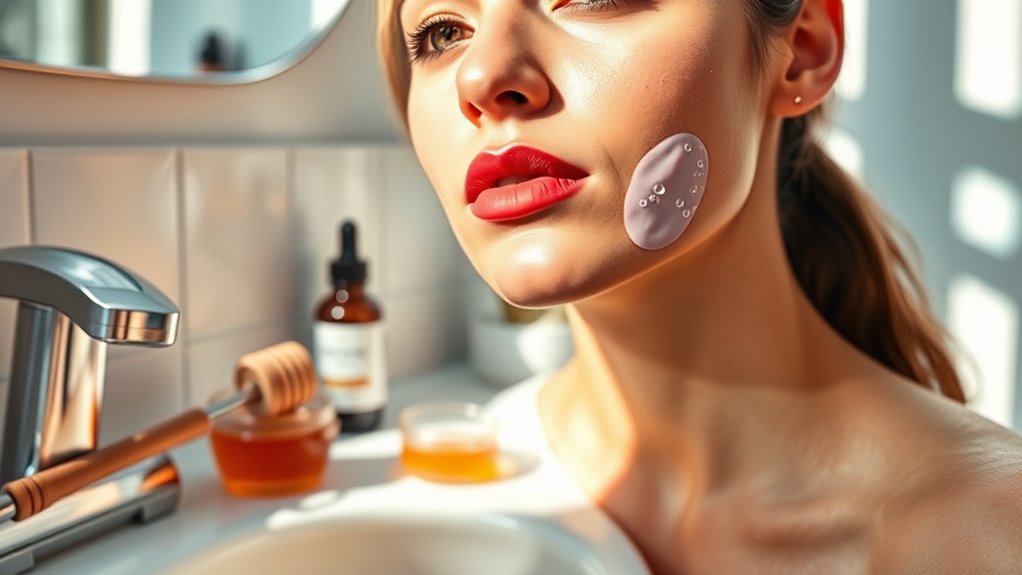
If you’re looking for alternatives to pimple patches, you have plenty of effective options at your fingertips.
Spot treatments with salicylic acid or benzoyl peroxide can quickly target acne-causing bacteria and penetrate deeper into pores. For a more natural approach, consider honey and aloe vera, which soothe inflammation and fight bacteria without harsh chemicals. Additionally, using medicated patches may provide targeted relief for more stubborn breakouts.
You can also try DIY hydrocolloid patches using hydrocolloid bandages, offering a cost-effective solution. Other natural options include apple cider vinegar patches and green tea ice cubes to calm your skin.
Maintaining a consistent skincare routine can help prevent new breakouts and manage existing acne, giving you a holistic approach to clearer skin without relying solely on commercial pimple patches.
Incorporating Pimple Patches Into Your Skincare Routine

Integrating pimple patches into your skincare routine can be a game-changer for managing breakouts effectively.
Start by cleansing your skin thoroughly, ensuring it’s clean and dry before applying the patch. Choose a patch that suits the size and type of your blemish, and apply it smoothly to avoid air bubbles.
For best results, leave the patch on overnight or for at least six hours. Patches absorb excess fluid while providing a protective barrier, helping you resist the urge to pick at your skin. This is because the occlusive nature of the patches locks in moisture, enhancing ingredient penetration for faster healing.
Monitor your skin’s reaction to avoid irritation, and feel free to combine patches with other gentle treatments for enhanced results.
With consistent use, you’ll likely notice reduced redness and faster healing.
Final Thoughts on 12 Hours With a Pimple Patch

After a long night with a pimple patch, you might be surprised by the results.
You’ll likely notice reduced inflammation and less redness, thanks to the patch’s ability to absorb excess oil and impurities. This barrier not only protects your skin from further irritation but also speeds up healing, minimizing the risk of scarring. Additionally, the patch functions like a vacuum cleaner for zits, ensuring that dirt and bacteria are kept at bay while promoting a healthier skin environment. Using a patch with active ingredients can enhance the benefits, but it’s also essential to consider essential oil safety when incorporating any topical treatments.
If you opted for a patch with active ingredients like salicylic acid or niacinamide, you may even see enhanced benefits.
However, keep in mind that while 12 hours can be effective, patches aren’t a cure-all, especially for deep cystic acne.
Remember to replace them if they become saturated, and allow your skin some breathing time afterward for ideal health.
Frequently Asked Questions
Can I Use Makeup Over a Pimple Patch?
Yes, you can absolutely use makeup over a pimple patch.
Just make sure your skin is clean and dry before applying the patch, as it works best that way.
When you apply makeup, use lightweight products gently to avoid dislodging the patch.
A colored concealer can help blend it seamlessly, while translucent powder sets everything for a smooth finish.
This way, you can conceal the patch while it continues to heal.
How Often Can I Use Pimple Patches in a Week?
Think of pimple patches as tiny shields in your skincare arsenal. You can use them daily, especially if your breakouts are persistent.
However, listen to your skin; if it starts feeling dry or irritated, give it a break. Typically, applying them for 4-8 hours works wonders, but you can leave them on overnight for stubborn spots.
Are Pimple Patches Safe for All Skin Types?
Pimple patches are generally safe for most skin types, but you should be cautious.
If you have sensitive skin, avoid patches with salicylic acid or benzoyl peroxide. Hydrocolloid patches are a great option for minimizing irritation.
Just make certain your skin is clean and dry before application. While they work well for surface-level acne, they’re not effective for deeper cystic pimples.
Always listen to your skin and consult a dermatologist if unsure.
Do Pimple Patches Expire?
Yes, pimple patches do expire.
Basic hydrocolloid patches typically last at least three years, while those with active ingredients, like salicylic acid, can degrade over time.
It’s essential you check the packaging for expiration dates and follow the manufacturer’s storage guidelines.
Store them in a cool, dry place, and inspect them visually or by smell before using.
If they show signs of damage or have expired, it’s best to discard them.
Can I Reuse a Pimple Patch?
Can you really reuse a pimple patch?
Think of it like trying to wear a sponge after it’s soaked up all the water—it’s just not effective. Once you’ve used it, the patch’s ability to absorb impurities is maxed out, and you risk spreading bacteria.
It’s best to toss it and reach for a fresh one. This way, you keep your skin safe and maximize healing—because your skin deserves the best treatment!
Conclusion
In just 12 hours, pimple patches can work wonders, like a tiny superhero battling blemishes while you sleep. They offer convenience and targeted treatment, making them a go-to for many. However, remember they’re not a cure-all. If you incorporate them wisely into your skincare routine, you’ll find they can be a valuable ally in your fight against breakouts. So, give them a shot, but don’t forget to explore other options for thorough care!
